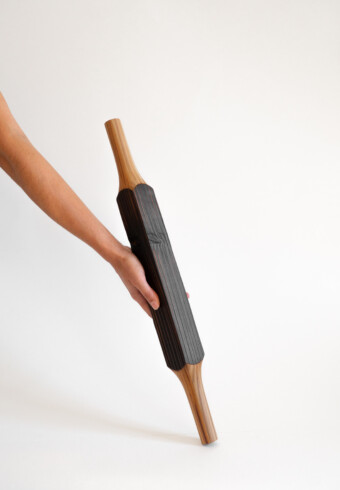









Cambio exhibition Formafantasma Studio

What is the overall impact of wood consumption? At the Serpentine Sackler Gallery in London, Amsterdam-based design studio Formafantasma goes to the source to explore the impact of voracious wood consumption.
Wood enters our daily life in various forms. It is all around us, not only in its obvious original state like the furniture we sit on and in the buildings we inhabit, but also in less obvious forms made possible by chemical processes that allow it to be used as an ingredient in items like paint, cosmetics and LCD screens. To understand the impact our voracious consumption of this material has on our planet, we need to trace the supply chain back to the source, which is exactly where designers Andrea Trimarchi and Simone Farresin from Studio Formafantasma us. take them to a new exhibition at the Serpentine Gallery in London.
Inaugurated on March 4, the exhibition, titled Cambio, focuses on the governance of timber extraction from forests. The survey links science, conservation, engineering and policy making and questions the role that design can play in building a better, more sustainable future.
Change
This title refers to the cambium, the tissue also called "second bark" which runs around each trunk, and which produces bark on the outside and wood on the inside. As a nod to this cambium layer, the exhibition plan follows a concentric structure with two rooms at its center. Here visitors will find interviews with specialists and a series of films made by Formafantasma. These include a monologue written and delivered by the philosopher and author Emanuele Coccia. Spoken from the point of view of a tree, the monologue is addressed to the entire human race.
“It presents a reversal of power structures on the planet, where you start to wonder who is in control,” says Simone Farresin from Formafantasma. “It's not just a provocation - it's an invitation to start thinking about what we do on the planet as a shared experience. As designers, we can no longer think that our role is only to meet human wants and needs. "
The origin and lifespan of wood
In the outdoor spaces of the gallery, an intense scent of forest designed by artist and nose Sissel Tolaas fills the air and brings the exhibits to life. As visitors enter, they are confronted with the trunk of a huge oak tree from Garnstone Forest in Herefordshire that has been cut into planks, dried and ready to use. The installation captures the tree in its transition phase from living being to object while providing a sense of scale.
Nearby, a series of wooden objects and contemporary products from Germany, Belgium and the Netherlands are on display. Each has been legally tested to reveal the origin of the wood it contains, and the surprising results are displayed on the wall. They reveal how protected and even endangered tree species are used for cheap applications, such as ping-pong bats or charcoal for barbecues.
“It is an invitation to consider what we do on the planet as a shared experience”
In another installation, the designers show the correlation between the amount of CO2 contained in an object and the length of time that the object should be used to offset its carbon. For example, a stool made from a fast growing tree would need to last 60 years, while a stool made from an oak tree would need a lifespan of over 120 years.
Material search
“We designed the exhibition as the start of the project rather than the end. We wanted to put research first. ” explains Farresin.
Although the emphasis is on thought processes, the studio has designed a series of furniture to display the research materials. A series of tables, stools, desks, chairs and shelves were then made from pine harvested in Val di Fiemme - a forest in northern Italy that was destroyed in 2018 by a storm caused by climate change. More than 13 million pine trees have been blown down by the strong winds.
“The entire exhibit uses wood from a single tree,” says Farresin. “Pine is a very soft wood, so we wanted to adopt it. We applied a varnish which is usually used in making musical instruments so that the surface becomes more durable. It is a transparent varnish with a little light gray which gives the pine a slightly “hazy” appearance. "
Formafantasma is no stranger to in-depth material research projects, while at the same time exploring the political and ecological responsibilities of design.
The entire Cambio project is freely available on the site www.cambio.website.









- Photographer: Gregorio Gonella & Formafantasma
- Location: London, UK
- Year: 2020
- Website: https://www.formafantasma.com
Share



